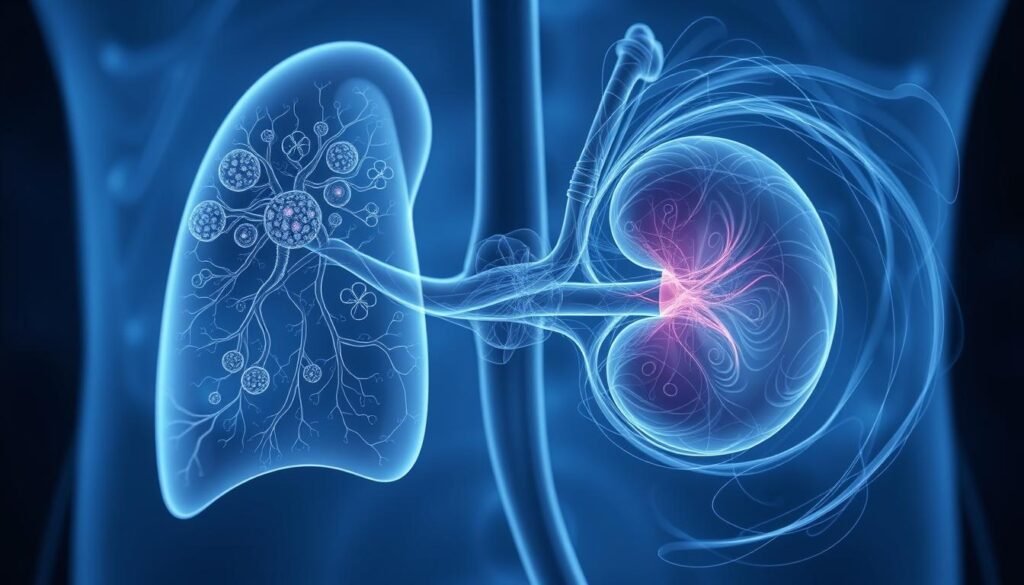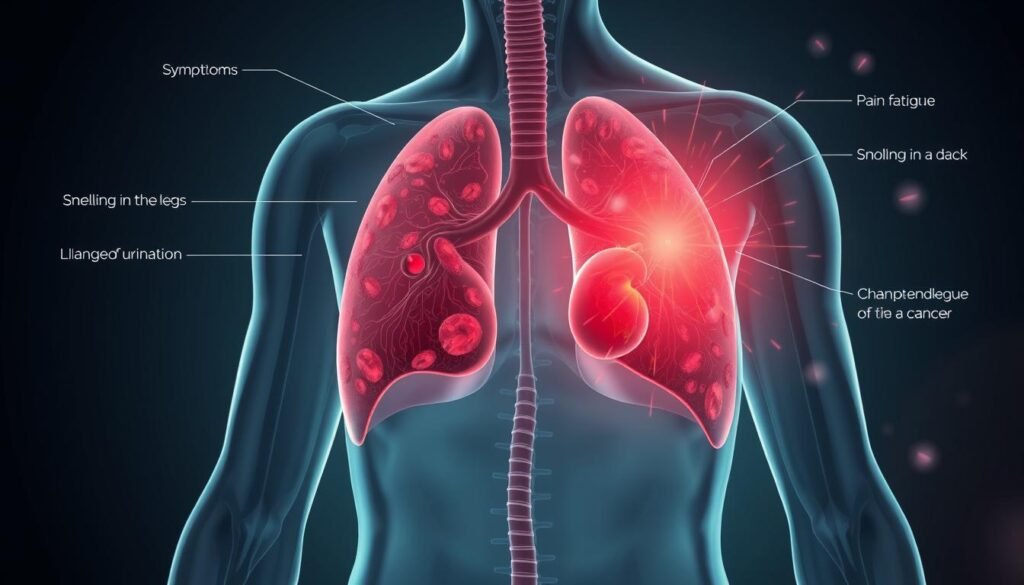Did you know that less than 5% of people with stage 4 lung cancer live past 5 years? This fact shows how serious lung cancer is, especially when it spreads to important organs like the kidneys. When lung cancer moves to other parts of the body, it can really change how long someone can live. So, it’s important to know all about it, including treatment and support for patients and their families.
This guide focuses on lung cancer reaching the kidneys, also known as renal metastasis. We’ll look at survival chances, what affects these chances, and life quality for those dealing with it. Our goal is to give people and their families the information they need. This can help make good decisions and improve care for those with advanced lung cancer.
Key Takeaways
- Stage 4 lung cancer has a low survival rate of about 5% over five years.
- Lung cancer who spread to the kidneys significantly impacts life expectancy and prognosis.
- Understanding treatment options is vital for managing advanced lung cancer.
- The quality of life can vary based on the individual’s overall health.
- Support resources for patients and caregivers are essential for navigating this journey.
Understanding Lung Cancer
Lung cancer is a leading cause of cancer in the United States. There are two main types: small cell lung cancer (SCLC) and non-small cell lung cancer (NSCLC). They differ in how fast they grow, how they spread, and how they are treated.
Lung cancer symptoms can be easy to overlook or confuse with less serious conditions. Signs to watch for include a persistent cough, chest pain, trouble breathing, and coughing up blood. Knowing these symptoms is key, as finding cancer early can greatly improve the chances of success with treatment.
There are several risk factors for lung cancer to be aware of. Smoking is the biggest one, causing most lung cancers. Secondhand smoke, environmental toxins, family history, and certain jobs also increase risk. Jobs that expose workers to asbestos, for example, can be particularly hazardous.
About 25% of all cancer deaths are caused by lung cancer, according to the American Lung Association. That’s why it’s so important to know the warning signs and get regular check-ups if you’re at risk.
| Lung Cancer Type | Characteristics |
|---|---|
| Small Cell Lung Cancer (SCLC) | Fast-growing, often diagnosed at an advanced stage |
| Non-Small Cell Lung Cancer (NSCLC) | More common, grows at a slower pace, includes subtypes like adenocarcinoma and squamous cell carcinoma |
What is Metastatic Lung Cancer?
Metastatic lung cancer is an advanced stage of lung cancer. It has spread from the lungs to other parts of the body. It’s vital to know what metastatic lung cancer means. Early detection changes treatment options and results.
The stages of lung cancer help us understand how far the disease has progressed. Stages 3A, 3B, and 3C are considered locally advanced. At this point, cancer might have reached nearby lymph nodes or distant organs. This includes the brain, bones, liver, adrenal glands, or other areas of the lungs.
https://www.youtube.com/watch?v=ihCnDjyJv5c
Survival rates for metastatic lung cancer decrease as the disease gets worse. For example:
| Stage | Type of Lung Cancer | 5-Year Relative Survival Rate |
|---|---|---|
| Stage 4 | Non-small cell lung cancer (NSCLC) | 9% |
| Stage 4 | Small cell lung cancer (SCLC) | 3% |
Talking about how cancer spread is key for both patients and doctors. A cancer specialist can give personalized advice based on individual cases. It’s important to look at all factors. This includes age, race, lifestyle, and genetic changes when managing lung cancer.
Common Sites of Lung Cancer Metastasis
Lung cancer often spreads to a few key organs. This spread affects patient outcomes and treatment choices. The bones, liver, brain, and kidneys are the main sites affected. The lungs are also a common spot for cancer to reach, with 20 to 54% of all tumors spreading there.
Knowing the metastatic sites lets doctors plan better treatments. When lung cancer reaches the kidneys, it guides therapy choices. Metastasis to the kidneys or elsewhere makes treating patients more complex.
Patients with lung or liver metastasis from colorectal cancer have a low five-year survival rate under 10%. This fact shows how serious lung cancer metastasis is. For lung cancer patients with widespread metastasis, the survival rate is around seven percent.
A table showing where lung cancer often spreads is helpful:
| Metastatic Site | Prevalence (%) |
|---|---|
| Bones | Approximately 30-40% |
| Liver | About 20-30% |
| Brain | Ranging from 20-30% |
| Kidneys | Varies around 10-15% |
This information is key for managing symptoms and improving treatments. Understanding metastatic sites helps doctors prevent problems and take better care of patients.
Lung Cancer Spread to Kidneys Life Expectancy
Patients with lung cancer that has spread to the kidneys have different prognoses. Knowing the life expectancy for metastatic lung cancer is key, especially when it affects the kidneys. As the cancer progresses to stage 4, the outlook gets much bleaker.
Survival Rates for Metastatic Lung Cancer
The five-year relative survival rate for stage 4 non-small cell lung cancer (NSCLC) is only 9%. Survival rates decrease with factors like age and gender. People younger than 50 have a 14.2% five-year survival rate. Those 65 and older have a 5.6% rate.
There are important differences within stage 4 NSCLC. For instance, stage 4a has a median survival of 11.4 months. But, stage 4b’s median survival drops to 6.3 months. These numbers highlight the seriousness of metastatic cancer.
Impact of Kidney Involvement on Prognosis
Kidney involvement makes the situation worse. Metastatic kidney cancer has about a 12% five-year survival rate. It affects how well treatments work and speeds up health decline. The kidneys filter toxins and help the body function, so their involvement complicates things.
This dual diagnosis changes treatment options and lowers life quality. Knowing this helps in making better health decisions.

Factors Affecting Life Expectancy
Patients with lung cancer spread to the kidneys face several challenges. These challenges affect how long they might live. Knowing the factors affecting cancer prognosis helps in understanding treatment options and survival chances.
The stage of the lung cancer and the patient’s overall health play a big role. This includes their age too.
Stage of Lung Cancer
The survival rate and prognosis of lung cancer depend a lot on its stage when diagnosed. Early-stage cases fare much better than late-stage ones. According to the SEER database, localized cancer has a 5-year survival rate of 93%. In contrast, distant-stage cancer’s rate drops to 17%. This shows why finding and treating cancer early is crucial.
Overall Health and Age
Your overall health and age impact how well you might handle cancer treatment. Younger, healthier patients typically have a better outlook. However, older adults and those with other health issues may not do as well.
Age-related problems can make treatment harder and slow down recovery. This makes getting a treatment plan that fits you vital for your health.
| Stage of Kidney Cancer | 5-Year Relative Survival Rate |
|---|---|
| Localized | 93% |
| Regional | 74% |
| Distant | 17% |
| All Stages Combined | 78% |
To better understand survival statistics, check out updated info like this guide on kidney cancer survival. It provides helpful details on how treatments may work for different people.
Symptoms of Lung Cancer Spread to Kidneys
When lung cancer spreads to the kidneys, several symptoms of metastasis may appear. It’s critical to know these signs for early action. Significant weight loss and fatigue that lasts all day are common. These can deeply impact one’s daily life and abilities.
One major sign is kidney pain. This pain can feel different from person to person because of the cancer in the kidneys. Changes in how often you pee, the color of your urine, or seeing blood are also warning signs. These changes could mean there are serious problems.
Knowing these lung cancer symptoms is key to getting help earlier. Symptoms of kidney cancer might look like lung cancer that has spread. It’s very important to get the right treatment for these signs. You can find more about living with metastatic lung cancer here. For info on where lung cancer often spreads, click here.

Treatment Options for Advanced Lung Cancer
Advanced lung cancer needs a carefully chosen treatment plan. There are many treatments aimed at controlling the disease and helping patients live better. These treatments, assessed by healthcare experts, include chemotherapy, radiation therapy, targeted therapy, and immunotherapy. They’re chosen based on the cancer type and the patient’s health.
Medical Treatments Available
Chemotherapy is a key treatment for advanced lung cancer. It uses strong medicine to kill cancer cells but can cause nausea and fatigue. Radiation therapy is also important. It helps control symptoms and targets tumors directly.
Targeted therapies play a big role in treating lung cancer. They attack specific mutations in some cancer types, like those with EGFR or ALK. This makes treatment more effective and can improve survival.
Immunotherapy uses the body’s own defense system against cancer. It aims to extend life and improve health. Many patients have seen good results with this approach.
Palliative care is crucial for advanced lung cancer patients. It focuses on easing pain, providing emotional support, and managing treatment side effects. Including palliative care early can greatly improve a patient’s experience.
| Treatment Type | Purpose | Common Side Effects |
|---|---|---|
| Chemotherapy | Kill rapidly dividing cells | Nausea, fatigue, hair loss |
| Radiation Therapy | Target specific tumors | Skin irritation, fatigue |
| Targeted Therapy | Act on specific mutations | Nausea, skin rash, diarrhea |
| Immunotherapy | Boost immune response | Fatigue, fever, cough |
Treatment choices must be tailored to the patient, considering the type of cancer and other health issues. For more on treatment options, check this resource for small cell lung cancer treatment details.
Palliative Care and Quality of Life
Palliative care is crucial for patients with lung cancer that’s spread to the kidneys. It aims to improve life quality by managing symptoms. Efforts include pain control, psychosocial support, and customized end-of-life care.
Those with advanced lung cancer face physical and emotional challenges. Care teams focus on comfort and address these issues directly. Educating patients and families about the journey ahead is a key part of this support.
Palliative care starts early, not just in cancer’s final stages. It boosts the quality of life by managing symptoms and providing emotional support. This approach helps patients feel better about their care.
Hospice care is for patients expected to live six months or less. It is based on clinical criteria and focuses on comfort. For specific guidelines, see the criteria outlined here.
| Clinical Status Indicators | Criteria for Hospice Eligibility |
|---|---|
| Karnofsky Performance Status (KPS) below 70% | Eligible for hospice coverage |
| Presence of distant metastases | Determines eligibility in cancer care |
| Rapid disease progression | Characterizes end-stage conditions |
| Decline in disease-directed therapy | Indicates need for increased support |
Palliative care significantly helps manage lung cancer, especially when it affects the kidneys. It focuses on patient needs, leading to dignified and peaceful end-of-life experiences. It makes challenging times easier for patients and their families.

Support for Patients and Caregivers
Lung cancer brings challenges for both patients and their caregivers. The stress it brings requires strong support systems. Caregiver resources help those who provide care. They help them deal with both the treatment and emotional support. For patients, getting the right information on lung cancer is key. It helps them make better decisions about their treatment.
Support groups play a crucial role. They’re a place where people can share their stories and feel less alone. In these groups, members find comfort and exchange helpful info. This can help reduce the feeling of being isolated. It empowers them to handle their situation better.
There are many types of resources available:
- Support Groups: Local and online groups for both patients and caregivers.
- Counseling Services: Mental health experts who specialize in cancer.
- Educational Resources: Books and websites to learn about treatments and how to cope.
- Financial Assistance: Help with the costs of treatment.
Caregivers must also take care of themselves. Using caregiver resources can lower their stress. It helps them stay helpful to those they’re caring for. Patients and families should talk openly about what they are going through. This creates a better support environment. It makes coping with lung cancer a little easier.
Resources for Symptom Management
Finding the right help for lung cancer symptoms is key. There are many groups and programs that offer support. They help people manage symptoms and make their lives better. Getting these resources can give strength to patients and their families in tough times.
The LUNGevity Lung Cancer Helpline is a great source of help, at 844-360-LUNG (5864). This helpline connects people to the resources they need. It makes sure they get the right help and information for their situation.
CancerCare® gives financial help to families who qualify, helping with costs related to cancer. It also has programs for specific groups or challenges. This makes it a valuable place for lung cancer support.
CancerCare also has virtual workshops in both English and Spanish. They provide the latest info in one-hour talks. Topics include managing symptoms and other important issues. This boosts the cancer care resources available to people.
- Magnolia Meals at Home: This service delivers meals to families dealing with cancer in certain areas. For details, contact Kathy Nugent, LCSW at 800-813-4673, ext. 6809.
- Nutritional Support: Eating well is crucial for managing symptoms. Many organizations offer food guidelines for lung cancer patients.
- Complementary Therapies: Patients might find relief in treatments like acupuncture and mindfulness. These can help reduce stress and symptoms of their disease.
Using these symptom management resources brings immediate comfort. It also builds a community and hope for people and families fighting lung cancer.
Conclusion
Lung cancer can spread to the kidneys, which is rare but serious. Knowing this helps understand the disease better. It shows why we need more research. We must know the difference between primary and secondary kidney tumors for the best treatment.
For those dealing with lung cancer, it’s vital to use all available resources. This helps in making informed decisions. Knowing about end-of-life care and metastasis issues prepares patients and families. Having a strong support network improves life quality during hard times.
It’s important to keep up-to-date on lung cancer and its effects on health. Patients should seek support and use all resources. Staying informed helps deal with this illness better. It leads to better care experiences.